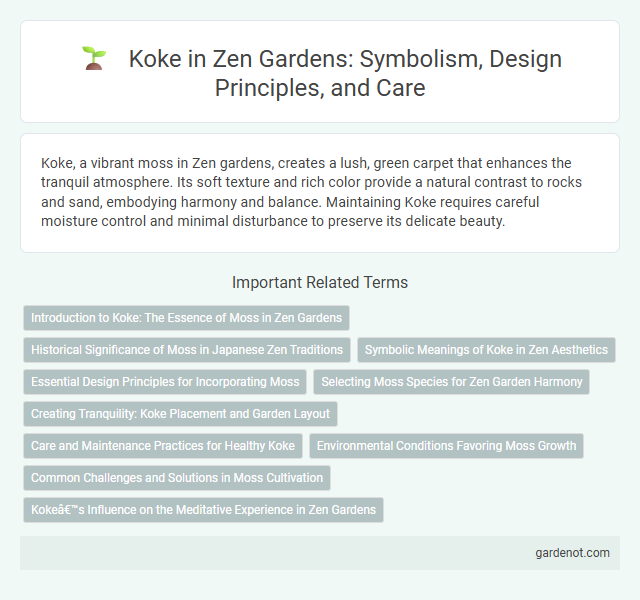Koke, a vibrant moss in Zen gardens, creates a lush, green carpet that enhances the tranquil atmosphere. Its soft texture and rich color provide a natural contrast to rocks and sand, embodying harmony and balance. Maintaining Koke requires careful moisture control and minimal disturbance to preserve its delicate beauty.
Introduction to Koke: The Essence of Moss in Zen Gardens
Koke, or moss, is a fundamental element in Zen gardens, symbolizing tranquility and age. Its dense, lush texture creates a soothing green carpet that enhances the garden's natural aesthetics and promotes mindfulness. The careful cultivation of Koke reflects the Zen principles of simplicity, patience, and harmony with nature.
Historical Significance of Moss in Japanese Zen Traditions
Koke, or moss, holds profound historical significance in Japanese Zen traditions as a symbol of simplicity, tranquility, and the passage of time. Its presence in Zen gardens dates back to the Muromachi period, where moss was carefully cultivated to create a meditative atmosphere reflecting Wabi-sabi aesthetics. The use of moss highlights the Zen philosophy of natural beauty and impermanence, embodying spiritual harmony between nature and human perception.
Symbolic Meanings of Koke in Zen Aesthetics
Koke, or moss, in Zen gardens symbolizes harmony, tranquility, and the passage of time, reflecting the impermanence emphasized in Zen philosophy. Its rich, green texture embodies simplicity and natural beauty, fostering a meditative atmosphere that invites mindfulness and inner calm. As a living element, Koke connects observers to nature's quiet persistence and the subtle balance between growth and decay.
Essential Design Principles for Incorporating Moss
Koke, or moss, is a vital element in Zen garden design, embodying simplicity and natural tranquility through its soft textures and deep green hues. Essential design principles for incorporating moss include selecting shaded, moist areas to encourage healthy growth, maintaining minimal disturbance to preserve its natural form, and integrating moss with stones and pathways to create harmonious contrasts. Proper moss care enhances the garden's serene ambiance by promoting natural growth cycles and blending with the garden's minimalist aesthetic.
Selecting Moss Species for Zen Garden Harmony
Selecting the right moss species is crucial for achieving harmony in a Zen garden. Shade-tolerant varieties like Hypnum and Dicranum create lush green carpets that thrive in moist, low-light conditions, enhancing tranquility. Each moss type contributes unique textures and colors, fostering a balanced and serene landscape integral to Zen garden aesthetics.
Creating Tranquility: Koke Placement and Garden Layout
Strategic Koke placement enhances the Zen garden's tranquility by mimicking natural moss growth patterns, fostering a serene and harmonious environment. The garden layout integrates Koke with stones, water, and sand to create balanced visual textures, promoting mindfulness and calm. Proper spacing and density of Koke contribute to a soothing ambiance that encourages contemplation and inner peace.
Care and Maintenance Practices for Healthy Koke
Healthy Koke moss thrives with consistent moisture, requiring regular misting or gentle watering to maintain its lush green appearance. It benefits from indirect sunlight and well-drained soil to prevent mold growth and ensure proper aeration. Removing debris and monitoring for pests supports its vitality and longevity in a Zen garden setting.
Environmental Conditions Favoring Moss Growth
Koke, or moss, thrives in shaded, humid environments with stable moisture levels and acidic to neutral soil pH, typically between 5.0 and 6.5. Low light exposure minimizes drying, while consistent moisture from morning dew or mist supports healthy moss proliferation in Zen gardens. Temperature ranges from 15degC to 25degC optimize enzymatic activity, ensuring robust growth and lush green coverage.
Common Challenges and Solutions in Moss Cultivation
Koke, or moss, often presents challenges such as maintaining adequate moisture levels and preventing weeds from overtaking the growth area in Zen gardens. Addressing these issues involves regular misting to keep the moss hydrated without waterlogging and manually removing unwanted plants to ensure the moss can thrive. Selecting shade-tolerant moss species and improving soil acidity further supports healthy moss cultivation and longevity.
Koke’s Influence on the Meditative Experience in Zen Gardens
Koke, or moss, enhances the meditative experience in Zen gardens by fostering a sense of tranquility and timelessness through its soft texture and vibrant green hues. Its natural growth encourages mindfulness as visitors observe subtle changes in color and moisture, promoting deep contemplation. The presence of Koke also symbolizes resilience and harmony with nature, reinforcing the garden's purpose as a spiritual refuge.
Koke Infographic

 gardenot.com
gardenot.com